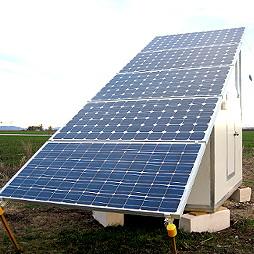Posted 27 July 2011

The new solar-powered gravity station on the Liverpool Plains
A new gravity field station funded by the National Centre for Groundwater Research and Training (NCGRT) has been set up on the Liverpool Plains as part of a research program studying water storage in clay sediments and leakage to underlying aquifers.
While groundwater levels in aquifers can be accurately measured using pressure loggers in boreholes, measuring the moisture content of soil is more challenging.
Soil moisture forms an important connection between surface water and groundwater, particularly in situations where rainfall recharges underground supplies by percolation to the water table.
Changes in measurements of gravity at a location over time can be related to changes in soil moisture content there. Gravimeters are used to accurately measure these minute changes in gravity.
The equipment at Liverpool Plains includes a gravimeter that can measure changes in gravity as small as 1 μGal, which is capable of detecting the effect of 2.4 cm rainfall on soil moisture levels. A μGal is a millionth of the unit of acceleration known as a Gal (Galileo), defined as 1 centimetre per second squared.
The solar-powered temperature-controlled gravity station has been set on a 10 m deep foundation to ensure a constant height datum in the shrinking and swelling clays at the site.
The station was assembled and tested at the UNSW Water Research Laboratory in Sydney before being transported to the site.
After drilling the foundation hole in May 2011, the station was installed in June 2011 and is now fully operational.
The station will be operated by Mr Sam McCulloch and Dr Anna Greve, who received specialized training in the use of the facility in Colorado last year.
The station will measure changes in soil moisture levels for at least the next 3 years.
The gravity data obtained in the study will be used to quantify changes in soil moisture storage at field scale.
This data is essential for improving understanding of drainage processes, close the water balance and quantify the effect of groundwater abstraction.
Links and further information:

Professor Andy Baker features in American Water Resources Association ‘Water Resources Impact’, September 2020 edition.

The Connected Waters Initiative (CWI) is pleased to welcome Taylor Coyne to its network as a postgraduate researcher. If you’re engaged in research at a postgraduate level, and you’re interested in joining the CWI network, get in touch! The CWI network includes multidisciplinary researchers across the Schools of Engineering, Sciences, Humanities and Languages and Law.

The Grand Challenge on Rapid Urbanisation will establish Think Deep Australia, led by Dr Marilu Melo Zurita, to explore how we can use our urban underground spaces for community benefit.

On the 21 August 2020, CWI researchers made a submission to the National Water Reform Inquiry, identifying priority areas and making a number of recommendations as to how to achieve a sustainable groundwater future for Australia.

Results published from a research project between the Land Development Department (LDD) Thailand and UNSW has demonstrated how 2-dimensional mapping can be used to understand soil salinity adjacent to a earthen canal in north east Thailand (Khongnawang et al. 2020).